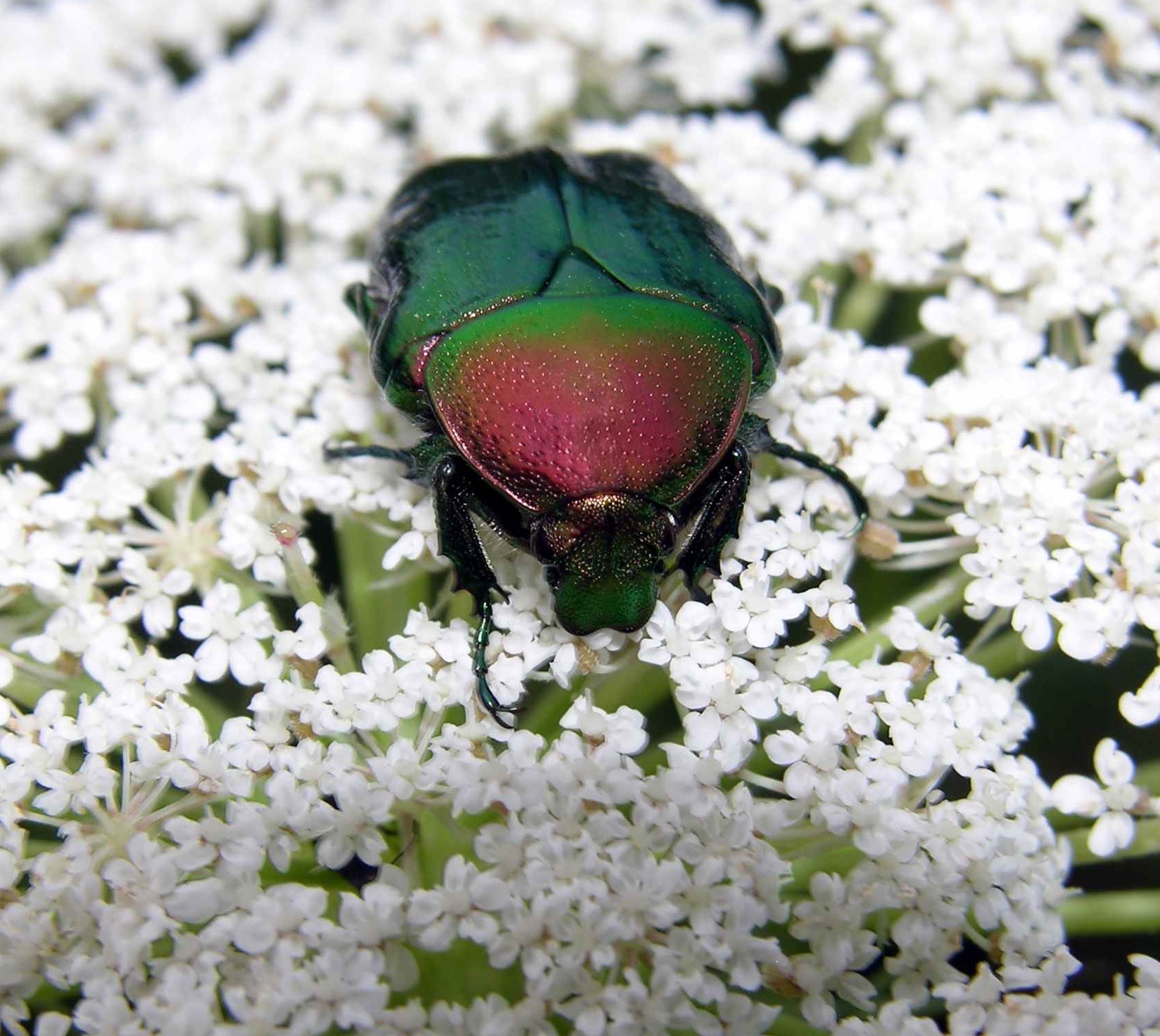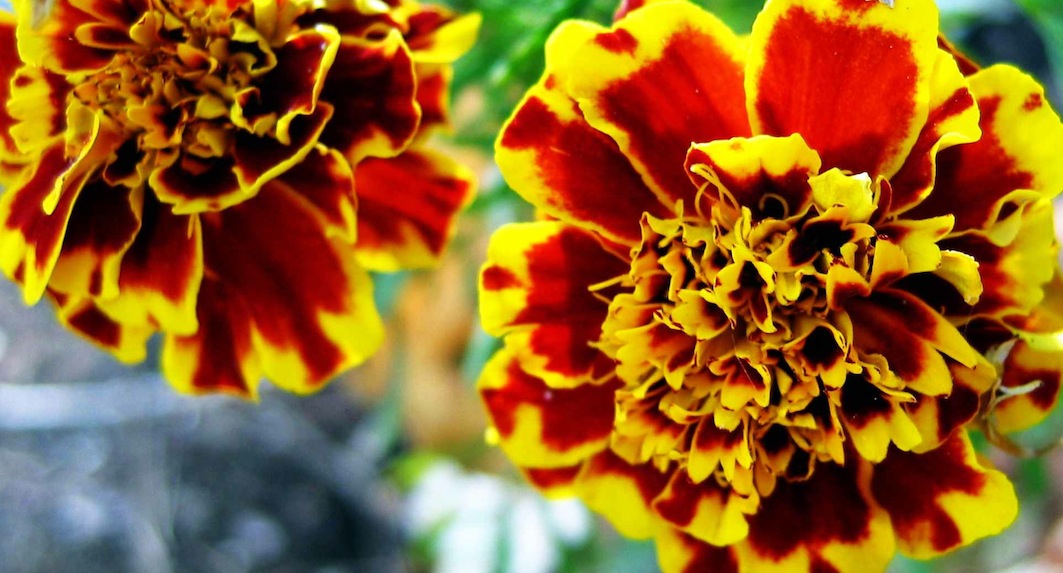Dear Reader, in this age of AI created content, please support with your goodwill someone who works harder to provide the human-made. Sign up at the top of the lefthand column or bottom of this page. You will receive my hand illustrated monthly newsletter RESTORE NATURE and access to the biodiversity garden design course as I write...and nothing else, I respect your time. I am also removing the advertizing as best I can as its become intrusive inappropriate and pays me nothing.
Garden pests
or garden blessed !
within an organic permaculture system

insects, whether harmless or garden pests, are often attracted to flowers
free picture (C) christian nitu from dreamstime stock photos
Pesky garden pests
One way to balance pests in the garden is to learn how to build an insect garden. I'll explain some things I learned about garden pests when I recently attended a lovely workshop by Saskia Schelling (saskia@gardencoach.co.za) and Karen Parkin (permaperson@gmail.com) who regularly give permaculture workshops in Saskia's "lab" or garden, and elsewhere.
In this fourth article in a series of five on companion planting in permaculture, I'll show how companion planting can help with pests, and if not, using other organic methods of saving your organic vegetables. At the end of the page I'll link you to the other articles in the series.
When planning vegetable gardens, integrate the herb garden design, because herbs have potent perfumes which can repel, confuse and lure pests away from your organic vegetables.
The cabbage butterfly reveals the complex life of garden pests
Nasturtiums are reputed to repel some insects, but they attract others, like the caterpillars of the cabbage butterfly. Thus they serve as a 'trap crop' or plantings which entice garden pests away from your main edible crops like cabbages. They are also edible, and can be used in salads and pickles.
The cabbage butterfly’s predators
attracted by flowers !
As discussed, the trap crop for cabbage butterfly is nasturtium. Planted with yarrow there is a double benefit. Wasps which parasitize cabbage butterfly are attracted by yarrow flowers, and so is another wasp, the paper wasp, which eats the caterpillar. The first wasps mentioned lay their larvae in the caterpillar’s body, and they hatch and devour all its nonessential organs, until they are ready to emerge. This gory story Karen has observed meticulously by catching the caterpillars and taking them to an agricultural researcher.
The uses of fences for larger 'garden pests', or uninvited guests
The vegetable area in Saskia's garden had a number of fences. In accordance with permaculture principles they are all multipurpose. Firstly they keep chickens out of the veggies. But the chickens are let out of their area under the banana trees for spells. They may wander and scratch in the food forest, where they eat the parasites, weed seeds, and fertilize the forest. Chickens like the vegetable patch and will destroy it quickly, as they need greens. Their destructiveness can be tempered, and their nutritional needs met by giving them a hanging bouquet of veggie leaves in their inclosure. Don’t just throw the leaves on the ground, they can get at them better when they are hanging.
Fences can double up as tomato trellises, and create a garden room.
Invasive plants
Plants can also be pests, when they get out of the garden for example. The forests on Table Mountain are full of 'escaped' garden plants and some have become a problem. Privet and Sesbania to name a few, but those with berries are like a wildfire and can be spread in bird droppings over huge gaps. Although Permaculture as a discipline is absolutely perfect in every other way, I have major differences with it concerning the use of invasive plants.
Guavas, mulberries and granadillas are fruiting plants with seeds eaten by birds, and which are invasive, and regulations about where they may be planted are there because their seed is spread by birds across huge distances, and cannot be controlled, so make sure you read up on this and consider it in the integrated whole.
the snail trial
To truly get rid of snails, nothing helps like hunting them. Collect them off brassicas at night with a head lamp says Saskia and feed them to ducks, chickens or I would add koi fish, which suck them out of the shells in seconds.
Do not worry about the work involved. Parasites come in waves, you will be able to sleep from time to time.
Then there is the third way, letting nature take care of them in the form of our indigenous carnivorous snails.. brilliant.
Introducing crop rotation
Microscopic and macroscopic pests can become problematic due to repeated planting in the same soil. Furthermore gardening science generally warns of the depletion of some nutrients with repeated planting, those that the particular plant needs. However, we have to look at scale. When you are talking a about extensive monocropping you can not apply the same rules to a diverse permaculture garden.
Saskia says they don’t need much crop rotation because her planting is so diverse, but they are thinking of trying it and only a small strip is being rotated on the outer rim of the veggie garden. The correct sequence would be first heavy then light feeders, such as first brassicas, then carrots. The full sequence would be: Legumes (with nitrogen fixing bacterial nodules), then leaf crops like brassicas and lettuce, then fruit crops, and finally root crops. She’s never seen frequent planting of the same plants in sequence cause nutrient deficiency in her permaculture garden, and the only time there was a clear deficiency was with the lemon tree which went yellow, and was revitalized with some epsom salts, volcanic ash and compost.
This is the fourth article out of five on companion planting in permaculture. The first dealt with guilds, the next with antagonism and beneficial plants. Then came planting up the garden and after this I will address the all important question of soil, and how permaculture principles are applied to weed and soil management.

qualifying the marigold's reputation as nematode repellent
FREE PICTURE (C) lakis fourouklas FROM DREAMSTIME STOCK PHOTOS
------
home page for other green ideas
------
vegetable gardening the natural low cost way
------
gardening and where it all started
------
link to the next companion planting workshop page on soil treatment
------
link to the previous companion planting page on planting a vegetable garden
You’re a home gardener ! Share your experiences and questions !
We all know about home gardening. Tell us about your successes, challenges and ask about issues that bother you. You may have the luxury of a back garden, but there are other ways we learn. Few people age without growing something or buying vegetables during their lives ! It is absolutely guaranteed that you have learned things which can help others on their gardening journey.
We invite you to share your stories, ask questions, because if a thing has bothered you it will bother others too. Someone may have a solution ! No question is too small. There is learning for everyone involved, for you, for me (yes, I learn from every question), for us all. Exciting stuff !
We are starting on a new journey. Every week we will profile your letters ! The best stories and questions we receive.
What Other Visitors Have Said
Click below to see contributions from other visitors to this page...
freaky garden snail 




this morning it was drizzling and I went outside and caught some naughty snails in my nursery
for snails have been targeting my tamarillos and that makes …
Snail city 




After the first rains the snails are out again with a vengeance, they are actually eating the paint off this wall ! They love it and congregate there. …
What nipped my catnip ? 




I am exploring soporific and calming herbs as I have bad insomnia (sleeping 4 hours a night) and anxious thoughts. I went out and bought expensive but …
Restore Nature Newsletter
I've been writing for four years now and I would love to hear from you
Please let me know if you have any questions, comments or stories to share on gardening, permaculture, regenerative agriculture, food forests, natural gardening, do nothing gardening, observations about pests and diseases, foraging, dealing with and using weeds constructively, composting and going offgrid.
SEARCH
Order the Kindle E-book for the SPECIAL PRICE of only
Prices valid till 30.09.2023
Recent Articles
-
garden for life is a blog about saving the earth one garden at a time
Apr 18, 25 01:18 PM
The garden for life blog has short articles on gardening for biodiversity with native plants and regenerating soil for climate amelioration and nutritious food -
Cape Flats Sand Fynbos, Cape Town's most endangered native vegetation!
Apr 18, 25 10:36 AM
Cape Flats Sand Fynbos, a vegetation type found in the super diverse Cape Fynbos region is threatened by Cape Town's urban development and invasive alien plants -
Geography Research Task
Jan 31, 25 11:37 PM
To whom it may concern My name is Tanyaradzwa Madziwa and I am a matric student at Springfield Convent School. As part of our geography syllabus for this
"How to start a profitable worm business on a shoestring budget
Order a printed copy from "Amazon" at the SPECIAL PRICE of only
or a digital version from the "Kindle" store at the SPECIAL PRICE of only
Prices valid till 30.09.2023










